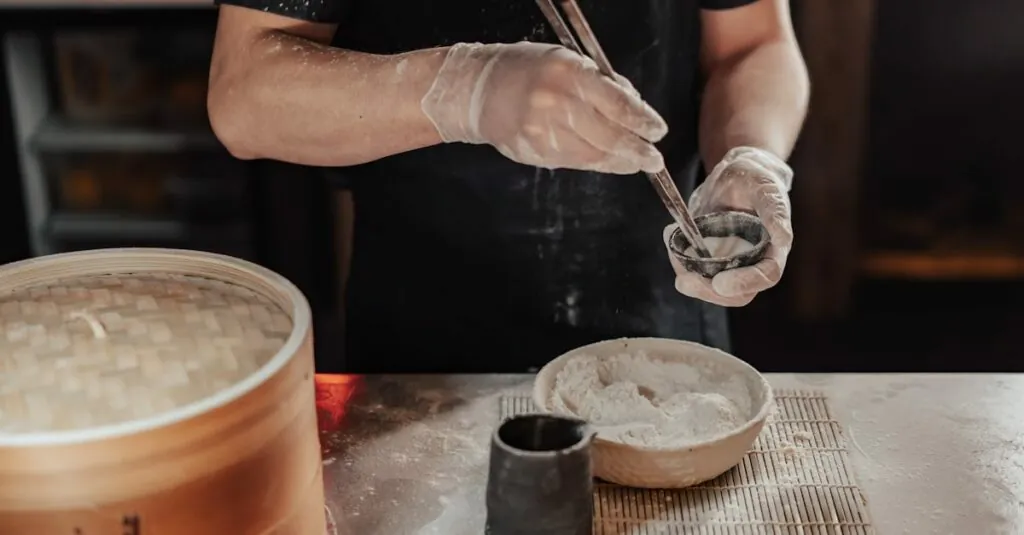Table of Contents
ToggleJapanese cooking techniques are a culinary adventure waiting to unfold. From the delicate art of sushi rolling to the precise mastery of tempura frying, these methods transform simple ingredients into extraordinary dishes. It’s not just about food; it’s about creating an experience that tantalizes the taste buds and delights the senses.
Imagine impressing your friends with a perfectly seared piece of fish, or dazzling them with a bowl of ramen that rivals your favorite restaurant. With a sprinkle of umami and a dash of technique, anyone can elevate their kitchen game. So grab your apron and get ready to dive into the world of Japanese cooking, where every slice, roll, and simmer brings a touch of magic to the table. Who knew cooking could be this much fun?
Overview of Japanese Cooking Techniques
Japanese cooking techniques emphasize precision and respect for ingredients. Each method highlights unique flavors and textures, creating a harmonious balance in dishes. Various techniques range from simple to complex, inviting both novice and experienced cooks to explore.
Searing is a common technique that enhances the taste of fish and meats. The high heat creates a flavorful crust while preserving moisture inside. Sushi rolling involves skillful layering of ingredients, showcasing fresh fish and vegetables wrapped in seasoned rice and seaweed.
Tempura frying offers a light and crispy texture to vegetables and seafood. The batter is made from a mixture of water and flour, allowing the natural flavors of the ingredients to shine through. Simmering, often used in preparing dishes like ramen, develops rich broths that serve as the foundation for many meals.
Grilling, known as yakitori when applied to skewered chicken, imparts a smoky flavor, enhancing the overall experience. Steaming is another essential technique that retains nutrients while offering a delicate texture, ideal for dishes like chawanmushi, a savory egg custard.
Pickling, or tsukemono, serves as a preservation method while introducing tangy and crunchy elements to meals. Fermentation techniques also play a significant role through miso and soy sauce production, enriching dishes with umami flavor profiles.
Overall, these techniques form the backbone of Japanese culinary traditions, allowing cooks to express creativity while appreciating the beauty of simplicity.
Key Techniques in Japanese Cuisine
Japanese cuisine employs a variety of precise techniques that enhance flavor and texture. Each method showcases the artistry involved in cooking.
Sushi and Sashimi Preparation
Sushi creation involves attention to detail, where fresh ingredients like fish and vegetables get carefully selected. Rice preparation plays a crucial role, requiring short-grain rice that becomes sticky when cooked. Techniques for cutting fish into sashimi require skillful knife work, ensuring uniform slices that maintain freshness. Quality matters in this process; using high-grade fish elevates the dish. Garnishes, such as wasabi and pickled ginger, complement the flavors and bring balance to the meal. Every element in sushi and sashimi preparation enhances the overall dining experience.
Sautéing and Stir-Frying
Sautéing incorporates high heat, allowing cooks to create quick, flavorful dishes. Often, fresh ingredients like vegetables and proteins are used in stir-fry, delivering satisfying crunch and taste. Japanese wok cooking often incorporates dashi, a broth that enhances flavor. Timing proves essential; ingredients must reach tenderness without losing texture. Oil selection, like sesame or vegetable oil, influences the final taste. Complements such as soy sauce add umami depth, making each bite memorable.
Noodle Cooking Methods
Noodle cooking showcases various techniques that ensure the perfect texture. Boiling soba or udon involves specific timing; overcooked noodles become mushy. Cold soba noodles often get dipped in a flavorful sauce, enhancing the dish’s enjoyment. Ramen making emphasizes broth quality, with simmering techniques extracting rich flavors from bones and vegetables. Stir-frying noodles fosters a delightful chewiness. Every method applies tradition while adding contemporary flair, achieving harmony in every dish.
Essential Tools for Japanese Cooking
Utilizing the right tools elevates the art of Japanese cooking. Essential items enhance precision and enrich the culinary experience.
Knives and Their Uses
Knives play a crucial role in Japanese cooking. A yanagiba knife, known for its long blade, excels at slicing raw fish for sushi and sashimi. Paring knives are ideal for intricate tasks, from peeling vegetables to precise cuts. The deba knife, with its thick blade, makes easy work of filleting fish. Skills hinge on using these knives correctly, emphasizing the importance of quality and maintenance. Regular sharpening ensures each knife performs optimally.
Cookware Overview
Cookware selection shapes how dishes turn out in Japanese cuisine. A heavy-bottomed pot distributes heat evenly, making it essential for recipe success. Clay pots, or donabe, offer unique thermal properties, ideal for stews and rice dishes. Steel pans enhance stir-frying and sautéing, allowing high-heat cooking while retaining flavors. Additionally, bamboo steamers are perfect for preparing dumplings and vegetables, promoting healthier cooking methods. Choosing the right cookware leads to better technique execution.
Regional Variations in Techniques
Japanese cooking showcases regional variations that highlight distinct culinary approaches. Techniques often differ between areas, reflecting local ingredients and cultural heritage.
Kanto vs. Kansai Cooking Styles
Kanto and Kansai represent two major culinary regions in Japan, each with unique cooking styles. Kanto cuisine emphasizes bold flavors, often featuring a stronger use of soy sauce. Popular dishes include sushi and tempura, reflecting this region’s preference for umami. Contrarily, Kansai cooking focuses on subtlety, with a lighter touch on seasonings. This style highlights dishes like okonomiyaki and yudofu, showcasing the natural sweetness of fresh ingredients. Both areas have their signature methods, contributing to the rich tapestry of Japanese culinary arts.
Traditional Techniques from Okinawa
Okinawa boasts a culinary tradition distinct from mainland Japan, emphasizing health and freshness. Techniques such as grilling and steaming dominate the cooking approach, often utilizing local seafood, vegetables, and tofu. Okinawan cuisine features dishes like goya champuru, a stir-fry with bitter melon, reflecting the island’s focus on nutrition. Braising methods are common as well, with pork belly being a staple, cooked slowly for tenderness. Traditional preparations celebrate local flavors, emphasizing the importance of ingredient sourcing. Each technique mirrors the island’s culture and lifestyle, contributing to its unique culinary identity.
Japanese cooking techniques offer a gateway to culinary creativity and appreciation for simplicity. By mastering these methods, anyone can elevate their cooking and impress diners with unique flavors and textures. The precision involved in each technique not only enhances the taste of dishes but also fosters a deeper connection to the ingredients used.
Exploring regional variations further enriches the experience, showcasing the diverse cultural influences that shape Japanese cuisine. Embracing these techniques and tools opens up a world of possibilities in the kitchen, allowing cooks to create memorable meals that celebrate the artistry of Japanese culinary traditions.







